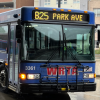When you spend a few hours in a cab with Jim Christie, like I recently did, you learn one thing pretty quickly. He sees almost everything, from how many other taxis are in the vicinity to potential fares lurking in the shadows to a quicker path opening up amidst a swell of traffic.
Christie's keen vision makes perfect sense. After all, when he started driving a cab, Kevin White was in his first term as mayor; John Havelicek was in his prime with the Celtics.
"It was back in the day when we still had uniforms," said Christie, "Waist jacket with a tie and a taxi hat."
Today, Christie is one of about 500 Boston taxi drivers who owns and operates his own cab.
"I’ve always made a good living at it. By buying that medallion, I bought myself a job, never to be laid off and I haven’t been broke, not one day since," said Christie.
But making a good living is getting harder.
"I’m not making the money I used to make," admitted Christie. "Every day it’s a guess."
In his 45 years behind the wheel, Christie’s seen boom times and lean years, but nothing like the snowballing slow days he's been experiencing lately. And after about an hour with no fares and the dispatch dead quiet, Christie set out to show me why.
Down at South Station, he pointed out a string of "gypsy cabs," gleaming black SUVs with a livery plates. They're allowed to pre-arrange a pickup, but not solicit one on the spot. Christie pointed out the cars' drivers, on the sidewalk and the station steps, trying to drum up business. He says it's like this here most days. "Meanwhile, these other guys, my fellow cab drivers, they’re just sitting there," he pointed out.
And over in the financial district – once a reliable moneymaker for Christie during the midday hours – we came face to face with the elephant in the room.
"There’s your UberX getting away right there," he remarked as a young woman, phone in hand, stepped into an car. "ten cars, ten cabs, alright, and she UberX’d."
Christie has no doubt that the gypsy cabs and rideshare companies like Uber are largely responsible for the sharp decline in his business – taxi ridership is down 22% so far this year alone. But he’s also quick to point out the many ways that the taxi industry has only itself to blame, rolling through a litany of chronic issues.
They let demand build up: "Before Uber was along, should they have put out 1,000 cabs? You bet they should have. And it would have worked."
They've turned a convenient form of payment into a perpetual headache: "We’re our own worst enemy. We just couldn’t get used to taking the credit card."
And, despite rules aimed to keep cabs clean and modern, too many are in a lowly state: "Here’s a guy right here, can’t fix his trunk," Christie remarked as we idled behind a battered Boston taxi with with a bungee cord holding it’s trunk closed.
As if on cue, one of our few fares of the afternoon, a developer named Rob Tullis, hopped into the cab, and bottom-lined the situation as he sees it, Christie nodding along with approval.
"The cabbies have only themselves to blame for creating a situation where it was easy to provide a better service," said Tullis. "But at the same time I’m completely sympathetic with them that that better competitive service is better and more competitive because it doesn’t have to do half the things that they have to do."
The “half the things” Tullis refers to are the host of regulations cabbies face that rideshare drivers don’t – from medallions to weekly dispatch fees, yearly licensing costs to expensive commercial insurance.
"If I have to pay 11,000 off the top, I have to get so much per mile," said Christie.
Christie says that if properly enforced, the regulations should mean for a better, safer customer experience, despite their cost to owners and drivers. And it’s in one of those regulations – the commercial insurance requirement – that Christie sees the best chance for a solution - and a more level playing field.
"Let them pay the four to five thousand dollars a year insurance," said Christie, referring to rideshare drivers. "That will take 40 percent of them off the road and there will be enough for everybody."
But of course it won’t be that simple. And perhaps nothing demonstrates just how complex – even contradictory – things have become for taxi drivers than the fact that Christie himself also works for Uber, taking advantage of their Uber Taxi service to help keep him afloat, as he watches their Uber X service cut into his business.
And so as the battle between Uber and taxis rages on in the press, at the state house, and in city hall, Christie will keep on driving - 14 hours a day. You can’t do what he’s done for as long as he’s done it without the patience of Job, and an eternal optimism that – somehow – tomorrow will be a better day than today.
"It might get a little more bumpier before it gets better," said Christie. "But once it’s figured out, it’s going to level off to a point where everybody is going to make money."




